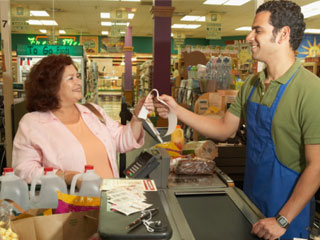6 Ways to Succeed with Check-Out-Line Charity
 Two articles last week, one in America Public Media the other in the WSJ, bemoaned the incessant requests at store registers for a dollar or two for causes. You should read them. It's a real bitchfest.
I'm not saying they're wrong. These constant requests can be annoying. Although what they think is kind of immaterial considering that supermarket giant Safeway alone last year raised $50 million for breast cancer charities and the Special Olympics with register programs.
Two articles last week, one in America Public Media the other in the WSJ, bemoaned the incessant requests at store registers for a dollar or two for causes. You should read them. It's a real bitchfest.
I'm not saying they're wrong. These constant requests can be annoying. Although what they think is kind of immaterial considering that supermarket giant Safeway alone last year raised $50 million for breast cancer charities and the Special Olympics with register programs.
But I get tired of these charity requests too. Not so much because they happen so often, but because they're executed so poorly.
But it doesn't have to be that way. Check-out-line charity programs (or pinup programs as I like to call them) can be a positive experience for the consumer and retailer. (I do many such programs during the year. Just search "pinup" in the upper right and you'll bring up a bunch of posts.)
Here are six ways to make sure shoppers aren't put-off by your next checkout program.
Walk the walk. Consumers can sniff out insincerity and disinterest a mile away. We've all been at checkouts and seen the signage from corporate, the unsold pile of pinups next to the register, the listless cashier with her half-hearted request. Do you hear the air hissing out of the balloon? If you're really committed to supporting a charity with a checkout program, don't just go through the motions. Involve your whole team from managers to cashiers, and instill them with a passion for the cause their efforts will support. And don't treat your cause campaign like a stray dog you plan to care for one day and then drop off at the pound the next day. This cause belongs to you now. Treat it accordingly.
Keep it simple - for everyone. Don't make the ask complicated. Just one sentence. "Would you like to donate a dollar to Komen for a Cure?" "Would you like to donate a dollar to help feed a poor family on Thanksgiving." Also, make it easy for consumers to support the cause and cashiers to process it. Either have a special button on the register to easily record the transaction, or include a UPC code on the pinups so they can be scanned just like any other product in the store. Finally, bite the bullet and put the charity first. Reduce the number of asks cashiers are responsible for (e.g. "Have you signed up for our credit card?", "Do you need batteries for that?") so they can focus on asking shoppers to support the cause.
Avoid pinup fatigue. A simple fact. If you deluge shoppers with requests to support a different cause every month they will HATE YOU. A supermarket chain I work with that did five pinup programs a year for different charities recently eliminated all of them citing shopper complaints. There's a shocker. They asked too often and shoppers grew to hate them, regardless of the cause. Every business is different, but I think one or two well run pinup programs a year is plenty.
Add perks for shoppers. In our pinup programs we include coupons that add value for consumers. Here's the pitch. "Would you like to donate a dollar to help a sick child? To thank you we'll include $175 in savings, including 10% off your next purchase here." Some retailers will even offer an immediate discount at the register if you buy a pinup.
Incentivize cashiers. I''ve explored whether or not incentives really work or not. When they are appropriate, it doesn't take much to incentives employees. A gift card to their favorite coffee house, a pizza party for the top performing store, etc. will often do the trick. And don't forget recognition incentives, which I'll be talking about in my next post. Bottom-line: incentives can make the difference between a good program and great one.
Try a passive program. If you think asking shoppers at the register to support a cause is too intrusive, try a passive program instead. Whole Foods is a leader in these programs. While you won't raise as much money as with traditional "active" programs, they can definitely be more popular with shoppers.
But I'm not the only who's done checkout charity. What tips would you add? Or just share how you feel about checkout programs in general. While it's hard to argue against their lucrativeness, the pros and cons of pinups always seem to incite a lot of debate!
